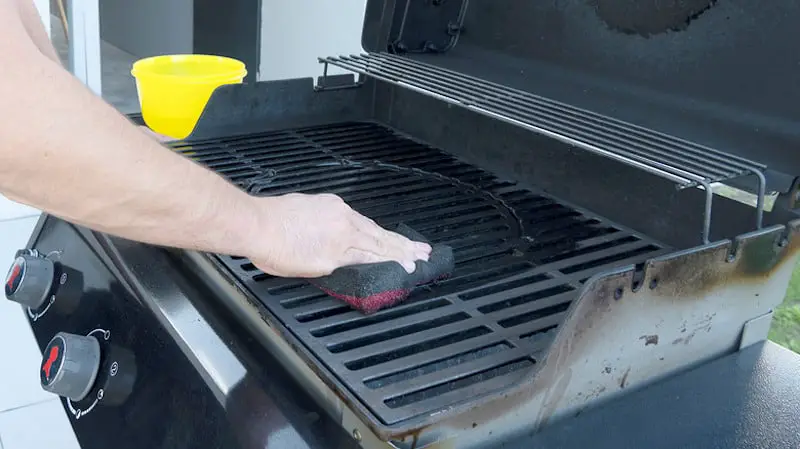Spice up your cooking game with the magic of dry rub! This versatile seasoning technique is a must-try for any grilling enthusiast or home cook looking to elevate their favorite meats and dishes.
In this blog post, we’ll explore what dry rubs are, why they’re essential in creating mouthwatering flavors, and how to apply them like a pro for sensational results every time.
Key Takeaways
- Dry rubs are a blend of dry spices and herbs that are applied to the surface of meat before cooking, which adds flavor and enhances the natural taste of the meat.
- Applying an appropriate amount of dry rub per pound of meat is crucial in achieving optimal flavor outcomes without overpowering the meat’s natural essence. For example, applying 1 tablespoon for every 1 pound of meat is a great starting point.
- Choosing the right type of seasoning blends per cut of meat can make a significant difference in elevating its flavors. For beef, pork, chicken, or fish, there are different spice combinations that work better with each protein due to their inherent richness and textures.
What Is Dry Rub And Why Use It?
Dry rub is a blend of dry spices and herbs that are applied to the surface of meat before cooking, which adds flavor and enhances the natural taste of the meat.
Definition Of Dry Rub
A dry rub is a flavorful blend of herbs, spices, and other dry ingredients that are carefully mixed and massaged onto the surface of various food items, typically meats to enhance the flavor of the meats. This method enhances the taste profile while preserving the meat’s natural flavors and textures.
For example, a popular barbecue dry rub may consist of ingredients such as paprika, onion powder, dried garlic granules, brown sugar, chili powder, and cumin seeds ground into spice powders – each component chosen to complement one another harmoniously when combined for use in specific dishes like grilled chicken or smoked pork ribs.
Advantages Of Using Dry Rub In Cooking
One significant advantage of using dry rubs over wet rubs in cooking is their ability to create a flavorful crust, or bark, on the surface of the meat. This delightful texture not only enhances the taste but also adds an appetizing color that can make any dish stand out.
Additionally, dry rubs often yield better results than marinades when it comes to achieving consistent seasoning throughout each cut of meat. Since they’re made up of spices and herbs mixed with sugar and sea salt, dry rubs penetrate deeper into meats like beef or smoked pork during cooking.
Unlike liquid marinades which can sometimes cause food to become soggy or over-saturated with flavors unrelated to meats themselves like overly acidic vinegar; this method allows your chosen spices to enhance grilled chicken wings without compromising their original taste.
Tips And Techniques For Applying Dry Rub

Choose the right type of meat, then apply the rub without oil or add some for better adhesion – read on to discover more essential tips and techniques that will help you perfectly season any cut of meat with the dry rub!
Choosing The Right Type Of Meat
Selecting the appropriate meat is essential for achieving optimal flavor and tenderness when using a dry rub. Begin by considering the type of protein you’d like to use, such as beef, pork, chicken, or fish.
For instance, dry rubs pair perfectly with beef brisket or ribs due to their inherent richness and fat content that helps break down during cooking. Similarly, pulled pork benefits from a flavorful dry rub because it enhances its succulent nature while retaining moisture in every bite.
Chicken wings, thighs, or whole birds can also benefit from the seasoning mix; however, be mindful of how long they need to cook on the grill so as not to overcook them.
Remember that each type of meat requires specific cooking methods and techniques suited for its unique characteristics so research beforehand what may suit your choice best before applying any seasoning blend.
Applying The Rub Without Oil
When using a dry rub, it’s possible to apply it without oil. Applying your meat dry by first patting down the surface of your meat with a paper towel will help the rub adhere to the meat.
The basic rule when applying a dry rub is that you should use 1 tablespoon of rub for every 1 pound of meat you’re cooking.
It’s important not to oversaturate your meat with too much seasoning which can overpower its natural flavor. Rubs are meant to enhance and complement, not completely take over.
A good dry rub will help tenderize the meat while also enhancing its natural flavors.
Adding Oil For Better Adhesion
One effective technique for ensuring that the dry rub adheres well to your meat is to add a small amount of oil. This not only helps the spices stick to the meat, but it also prevents them from falling off during cooking.
Olive oil is an excellent choice for this purpose, as it does not interfere with the flavor of the spices. You can mix a tablespoon or two of olive oil with your favorite dry rub ingredients to form a paste-like mixture and evenly apply it onto different sides of the meat using your hands.
By adding just enough oil or vinegar before applying the dry rub, you’re allowing the flavors and aromas of herbs and spices in your seasoning blend to penetrate better into every grain of the meat fibers throughout cooking time.
Not only will this improve taste and texture but also contribute much-needed moisture retention as these liquids help keep meats tenderized while on heat.
The Recommended Amount Of Rub Per Pound Of Meat
When it comes to applying dry rub, the amount used can make a big difference in the flavor outcome. As a general rule of thumb, you should apply approximately 1 tablespoon of dry rub per pound of meat.
However, keep in mind that this is just a starting point and may vary depending on factors like personal preference and the type of meat being cooked.
Additionally, it’s important to note that salt should be omitted from homemade dry rubs as it draws moisture out of the meat and can result in a tough texture. To ensure proper adhesion, pat your chosen cut of meat dry using paper towels before massaging the rub directly onto its surface.
Massaging The Rub Into The Meat
Once you’ve applied the dry rub, it’s time to massage it in. Massaging helps the rub adhere to the meat and penetrate deeper, resulting in a flavorful crust on the surface of your protein.
Patting down or simply sprinkling the rub won’t cut it.
Remember not to rub too hard; otherwise, you might remove some of the seasonings you just added! Take brisket for instance – this requires a bit more massaging because they’re bigger cuts that require additional flavoring penetration.
How To Apply Dry Rub For Different Types Of Meats
Applying dry rubs for different meats requires knowledge of the best seasoning blends per cut of meat, and how much to apply depending on the weight.
Beef, Pork, Chicken, And Fish
Dry rubs are versatile and can be used to add flavor to various types of meats. Here are some ways to use dry rubs for beef, pork, chicken, and fish:
- Beef: A good dry rub for beef should have a high ratio of salt to sugar for a more savory taste. Paprika is also a popular ingredient in beef rubs. Apply the rub generously onto the surface of the meat and massage it gently.
- Pork: Dry rubs that have a sweet flavor work well with pork. Brown sugar and smoked paprika are common ingredients in pork rubs. Rub the seasoning onto the meat, making sure to apply it evenly and massage it gently.
- Chicken: For a dry rub for chicken, you can use an all-purpose poultry seasoning blend or create your own by mixing dried herbs like thyme, rosemary, sage, and onion powder. Sprinkle the rub onto the surface of the meat before grilling or smoking.
- Fish: When using a dry rub on fish, choose one with mild spices like garlic powder or herb blends that won’t overpower its natural flavor. Ensure that you pat the fish dry using paper towels before applying the seasonings to help the rub adhere better.
Remember to apply your chosen dry rub evenly over all sides of your meat and massage it in gently before cooking it using your preferred method such as grilling or smoking.
Popular Seasoning Blends For Different Types Of Meats
Dry rubs are a great way to enhance the natural flavors of different types of meats. Here are some popular seasoning blends for different types of meats:
- Beef: A classic beef rub contains salt, black pepper, garlic powder, and paprika. For a more intense flavor, you can add chili powder or cumin.
- Pork: A pork rub typically consists of brown sugar, paprika, salt, garlic powder, and onion powder. For a spicier version, you can add cayenne pepper or red pepper flakes.
- Chicken: A chicken rub usually contains salt, black pepper, paprika, onion powder, and garlic powder. You can also add herbs like thyme or rosemary for an extra burst of flavor.
- Fish: A fish rub generally includes smoked paprika, lemon zest, garlic powder, and dried herbs like dill or parsley. For a stronger flavor profile, you can add chili flakes or cumin.
Using these seasoning blends will not only make your meat flavorful but will also help tenderize it by breaking down its fibers and drawing out the moisture using salt in the dry rubs. Remember to apply just enough dry rub to coat all sides of the meat without overdoing it as that may result in an overpowering taste.
Cooking With Dry Rub
After applying a dry rub to your meat, cooking it properly is key in bringing out the flavors you’ve added. When grilling or smoking meats with a dry rub, make sure to cook them at low temperatures and over an extended period.
For example, when smoking pork ribs with a dry rub, aim for a temperature between 225-250°F and cook them for approximately five hours.
When cooking chicken with a dry rub on the grill, keep in mind that poultry can easily become dry if overcooked. For this reason, use indirect heat by placing chicken away from direct flames on your grill.
Finally, remember that not all meats should be cooked using every available method – some cuts of meat may benefit more from one kind of preparation than another.
Conclusion
In conclusion, dry rubs are a quick and easy way to add flavor to your meats. By choosing the right type of meat, using the appropriate amount of rub per pound of meat, and properly applying the rub with oil or directly onto the surface of the meat, you can enhance the natural flavors and tenderize your meats.
Dry rubs also allow for a crispy crust when grilling or baking. So next time you want to spice up your dinner game, try using a homemade dry rub recipe on your favorite cut of meat.
FAQs:
1. How long should I let my meat marinate with the dry rub?
The length of time you leave your meat to marinate depends on personal preference and the type of meat being used. Generally speaking, letting your meat rest in the fridge with the dry rub anywhere from 30 minutes up to 24 hours will result in more intense flavors.
2. Can I use a dry rub on vegetables as well?
Yes! Dry rubs can add flavor and texture to many types of roasted or grilled vegetables such as sweet potato wedges, cauliflower steaks, and corn-on-the-cob among others.
3. Is there a specific way to store leftover dry rub?
To ensure maximum freshness and potency for future uses – once mixed together – keep your homemade spice blends stored tightly sealed container away from light, heat & moisture; ideally in an opaque glass jar or ceramic container which are air-tight so that they stay fresh and longer-lasting results without clumping or losing their aroma over time.




Leave a Reply